Detailed Taxation Report: CGT, FBT, and Business Transactions Analysis
VerifiedAdded on 2023/06/04
|13
|3932
|212
Report
AI Summary
This report provides a detailed analysis of the tax implications, specifically Capital Gains Tax (CGT) and Fringe Benefits Tax (FBT), arising from various business transactions. It examines Amber's sale of a chocolate shop, including the tax treatment of goodwill, equipment, and stock, as well as the implications of a restrictive covenant. The report also covers the CGT implications of selling an inherited inner-city apartment, focusing on the main residence exemption. Furthermore, it addresses the tax implications for both employer (House R Us) and employee (Jamie) concerning salary, commission, car benefits, and low-interest loans, determining assessable income, tax deductions, and FBT liabilities. The analysis is supported by relevant sections of the ITAA 1997 and FBTAA 1986, along with case law and tax rulings.
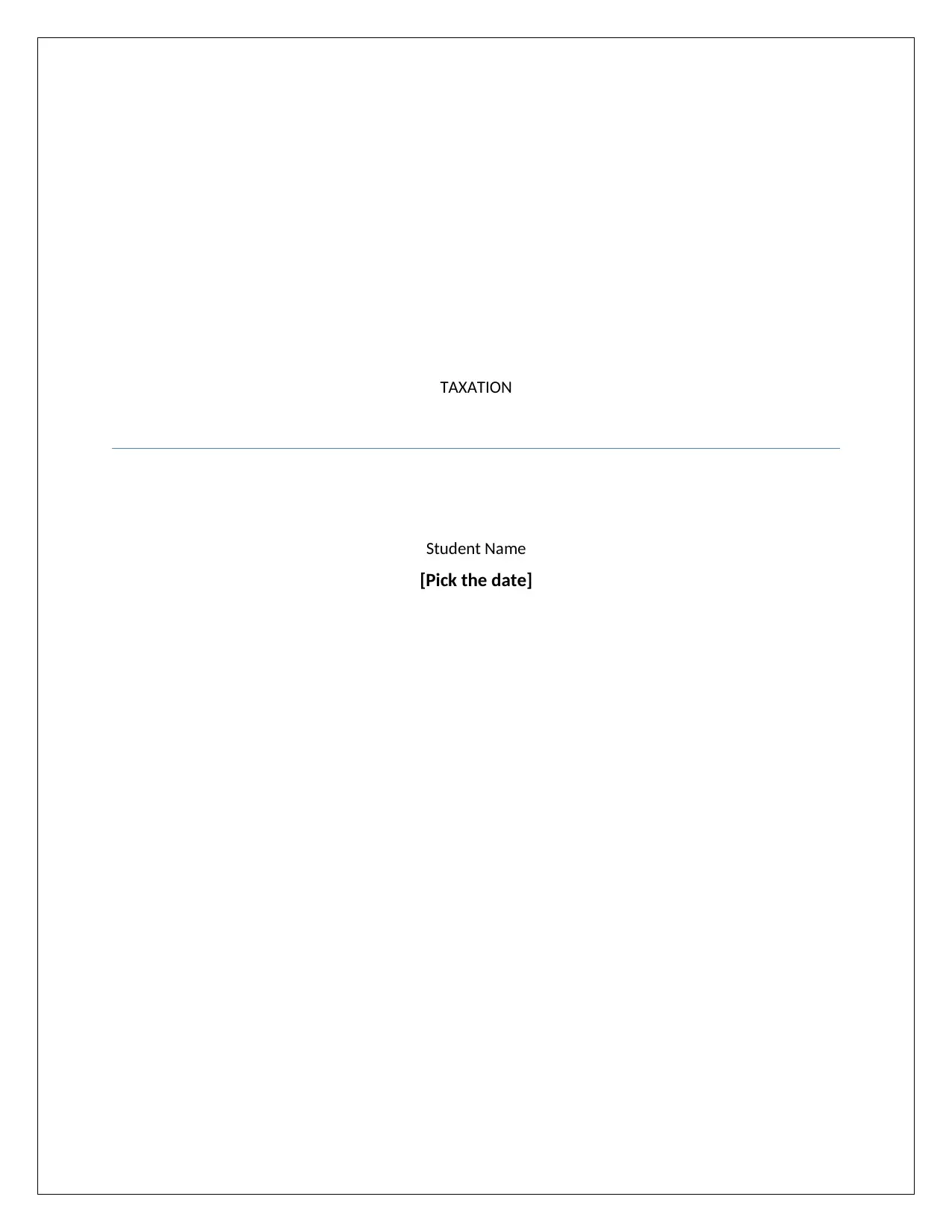
TAXATION
Student Name
[Pick the date]
Student Name
[Pick the date]
Paraphrase This Document
Need a fresh take? Get an instant paraphrase of this document with our AI Paraphraser
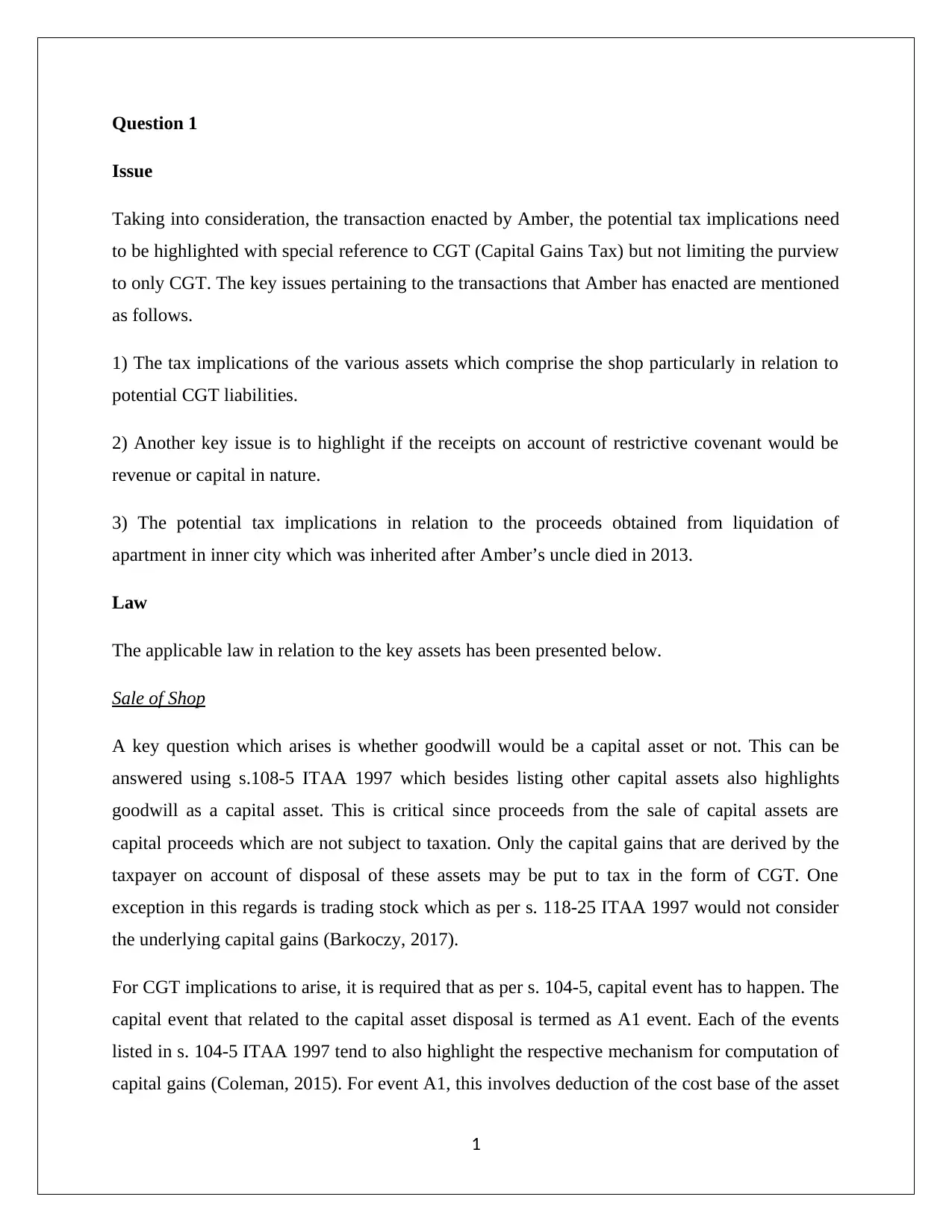
Question 1
Issue
Taking into consideration, the transaction enacted by Amber, the potential tax implications need
to be highlighted with special reference to CGT (Capital Gains Tax) but not limiting the purview
to only CGT. The key issues pertaining to the transactions that Amber has enacted are mentioned
as follows.
1) The tax implications of the various assets which comprise the shop particularly in relation to
potential CGT liabilities.
2) Another key issue is to highlight if the receipts on account of restrictive covenant would be
revenue or capital in nature.
3) The potential tax implications in relation to the proceeds obtained from liquidation of
apartment in inner city which was inherited after Amber’s uncle died in 2013.
Law
The applicable law in relation to the key assets has been presented below.
Sale of Shop
A key question which arises is whether goodwill would be a capital asset or not. This can be
answered using s.108-5 ITAA 1997 which besides listing other capital assets also highlights
goodwill as a capital asset. This is critical since proceeds from the sale of capital assets are
capital proceeds which are not subject to taxation. Only the capital gains that are derived by the
taxpayer on account of disposal of these assets may be put to tax in the form of CGT. One
exception in this regards is trading stock which as per s. 118-25 ITAA 1997 would not consider
the underlying capital gains (Barkoczy, 2017).
For CGT implications to arise, it is required that as per s. 104-5, capital event has to happen. The
capital event that related to the capital asset disposal is termed as A1 event. Each of the events
listed in s. 104-5 ITAA 1997 tend to also highlight the respective mechanism for computation of
capital gains (Coleman, 2015). For event A1, this involves deduction of the cost base of the asset
1
Issue
Taking into consideration, the transaction enacted by Amber, the potential tax implications need
to be highlighted with special reference to CGT (Capital Gains Tax) but not limiting the purview
to only CGT. The key issues pertaining to the transactions that Amber has enacted are mentioned
as follows.
1) The tax implications of the various assets which comprise the shop particularly in relation to
potential CGT liabilities.
2) Another key issue is to highlight if the receipts on account of restrictive covenant would be
revenue or capital in nature.
3) The potential tax implications in relation to the proceeds obtained from liquidation of
apartment in inner city which was inherited after Amber’s uncle died in 2013.
Law
The applicable law in relation to the key assets has been presented below.
Sale of Shop
A key question which arises is whether goodwill would be a capital asset or not. This can be
answered using s.108-5 ITAA 1997 which besides listing other capital assets also highlights
goodwill as a capital asset. This is critical since proceeds from the sale of capital assets are
capital proceeds which are not subject to taxation. Only the capital gains that are derived by the
taxpayer on account of disposal of these assets may be put to tax in the form of CGT. One
exception in this regards is trading stock which as per s. 118-25 ITAA 1997 would not consider
the underlying capital gains (Barkoczy, 2017).
For CGT implications to arise, it is required that as per s. 104-5, capital event has to happen. The
capital event that related to the capital asset disposal is termed as A1 event. Each of the events
listed in s. 104-5 ITAA 1997 tend to also highlight the respective mechanism for computation of
capital gains (Coleman, 2015). For event A1, this involves deduction of the cost base of the asset
1
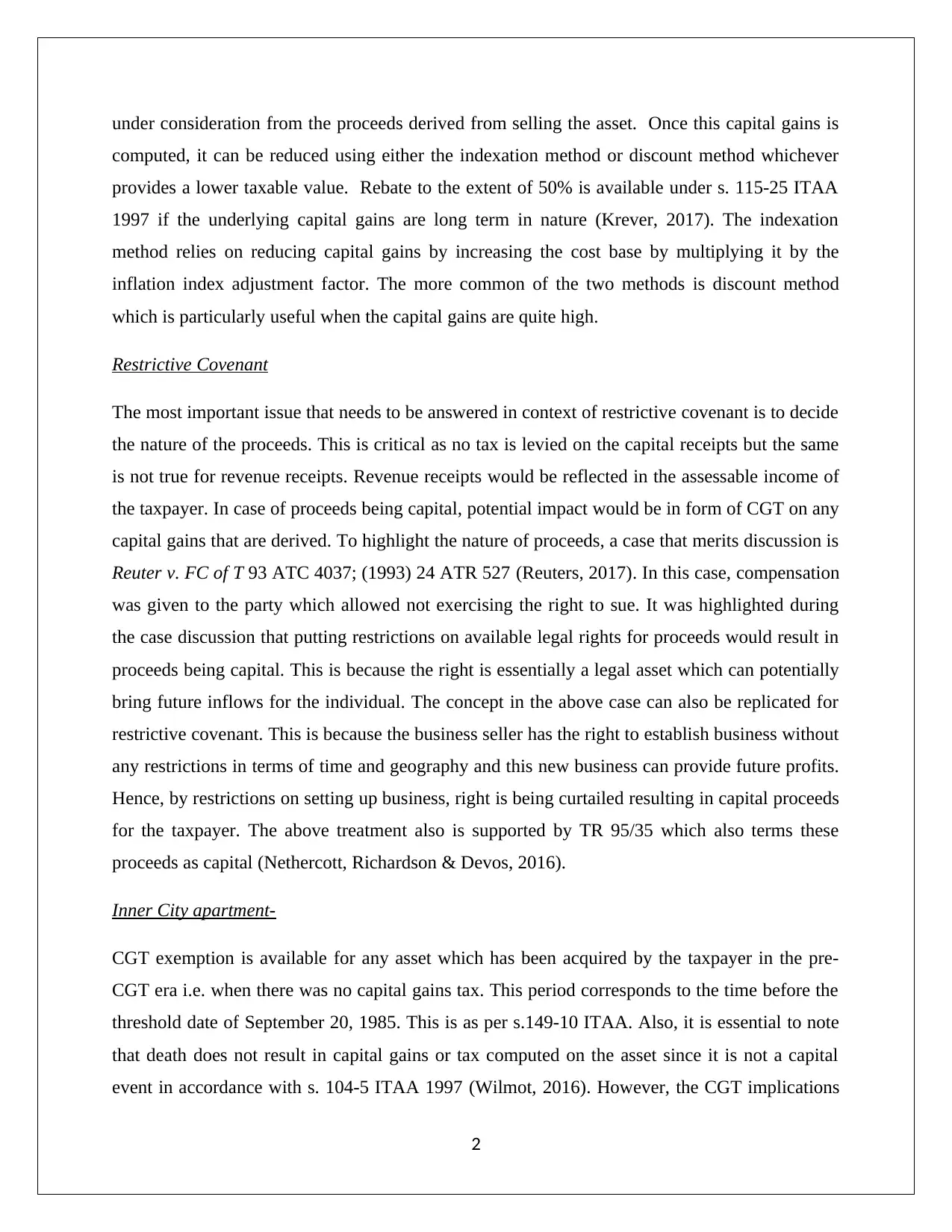
under consideration from the proceeds derived from selling the asset. Once this capital gains is
computed, it can be reduced using either the indexation method or discount method whichever
provides a lower taxable value. Rebate to the extent of 50% is available under s. 115-25 ITAA
1997 if the underlying capital gains are long term in nature (Krever, 2017). The indexation
method relies on reducing capital gains by increasing the cost base by multiplying it by the
inflation index adjustment factor. The more common of the two methods is discount method
which is particularly useful when the capital gains are quite high.
Restrictive Covenant
The most important issue that needs to be answered in context of restrictive covenant is to decide
the nature of the proceeds. This is critical as no tax is levied on the capital receipts but the same
is not true for revenue receipts. Revenue receipts would be reflected in the assessable income of
the taxpayer. In case of proceeds being capital, potential impact would be in form of CGT on any
capital gains that are derived. To highlight the nature of proceeds, a case that merits discussion is
Reuter v. FC of T 93 ATC 4037; (1993) 24 ATR 527 (Reuters, 2017). In this case, compensation
was given to the party which allowed not exercising the right to sue. It was highlighted during
the case discussion that putting restrictions on available legal rights for proceeds would result in
proceeds being capital. This is because the right is essentially a legal asset which can potentially
bring future inflows for the individual. The concept in the above case can also be replicated for
restrictive covenant. This is because the business seller has the right to establish business without
any restrictions in terms of time and geography and this new business can provide future profits.
Hence, by restrictions on setting up business, right is being curtailed resulting in capital proceeds
for the taxpayer. The above treatment also is supported by TR 95/35 which also terms these
proceeds as capital (Nethercott, Richardson & Devos, 2016).
Inner City apartment-
CGT exemption is available for any asset which has been acquired by the taxpayer in the pre-
CGT era i.e. when there was no capital gains tax. This period corresponds to the time before the
threshold date of September 20, 1985. This is as per s.149-10 ITAA. Also, it is essential to note
that death does not result in capital gains or tax computed on the asset since it is not a capital
event in accordance with s. 104-5 ITAA 1997 (Wilmot, 2016). However, the CGT implications
2
computed, it can be reduced using either the indexation method or discount method whichever
provides a lower taxable value. Rebate to the extent of 50% is available under s. 115-25 ITAA
1997 if the underlying capital gains are long term in nature (Krever, 2017). The indexation
method relies on reducing capital gains by increasing the cost base by multiplying it by the
inflation index adjustment factor. The more common of the two methods is discount method
which is particularly useful when the capital gains are quite high.
Restrictive Covenant
The most important issue that needs to be answered in context of restrictive covenant is to decide
the nature of the proceeds. This is critical as no tax is levied on the capital receipts but the same
is not true for revenue receipts. Revenue receipts would be reflected in the assessable income of
the taxpayer. In case of proceeds being capital, potential impact would be in form of CGT on any
capital gains that are derived. To highlight the nature of proceeds, a case that merits discussion is
Reuter v. FC of T 93 ATC 4037; (1993) 24 ATR 527 (Reuters, 2017). In this case, compensation
was given to the party which allowed not exercising the right to sue. It was highlighted during
the case discussion that putting restrictions on available legal rights for proceeds would result in
proceeds being capital. This is because the right is essentially a legal asset which can potentially
bring future inflows for the individual. The concept in the above case can also be replicated for
restrictive covenant. This is because the business seller has the right to establish business without
any restrictions in terms of time and geography and this new business can provide future profits.
Hence, by restrictions on setting up business, right is being curtailed resulting in capital proceeds
for the taxpayer. The above treatment also is supported by TR 95/35 which also terms these
proceeds as capital (Nethercott, Richardson & Devos, 2016).
Inner City apartment-
CGT exemption is available for any asset which has been acquired by the taxpayer in the pre-
CGT era i.e. when there was no capital gains tax. This period corresponds to the time before the
threshold date of September 20, 1985. This is as per s.149-10 ITAA. Also, it is essential to note
that death does not result in capital gains or tax computed on the asset since it is not a capital
event in accordance with s. 104-5 ITAA 1997 (Wilmot, 2016). However, the CGT implications
2
⊘ This is a preview!⊘
Do you want full access?
Subscribe today to unlock all pages.

Trusted by 1+ million students worldwide
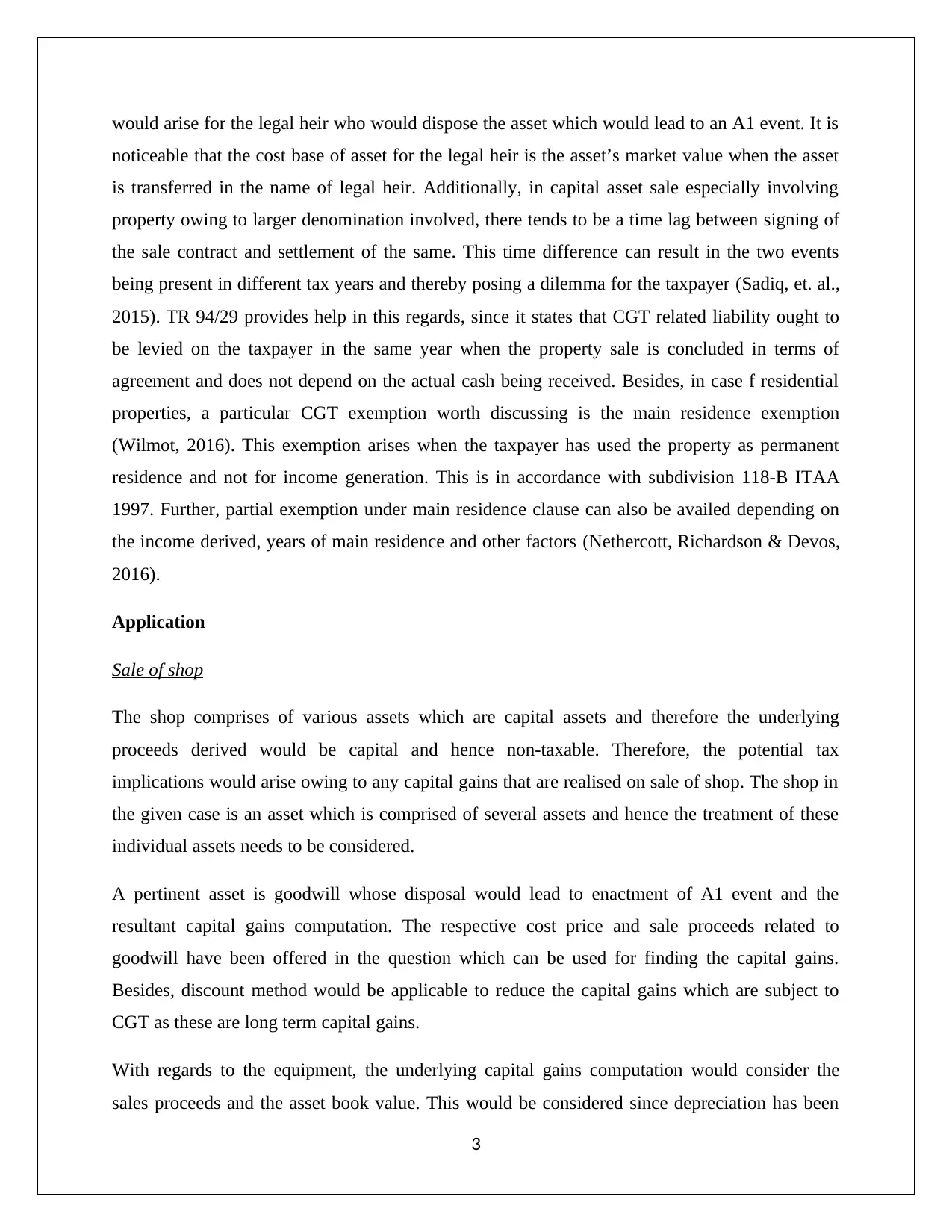
would arise for the legal heir who would dispose the asset which would lead to an A1 event. It is
noticeable that the cost base of asset for the legal heir is the asset’s market value when the asset
is transferred in the name of legal heir. Additionally, in capital asset sale especially involving
property owing to larger denomination involved, there tends to be a time lag between signing of
the sale contract and settlement of the same. This time difference can result in the two events
being present in different tax years and thereby posing a dilemma for the taxpayer (Sadiq, et. al.,
2015). TR 94/29 provides help in this regards, since it states that CGT related liability ought to
be levied on the taxpayer in the same year when the property sale is concluded in terms of
agreement and does not depend on the actual cash being received. Besides, in case f residential
properties, a particular CGT exemption worth discussing is the main residence exemption
(Wilmot, 2016). This exemption arises when the taxpayer has used the property as permanent
residence and not for income generation. This is in accordance with subdivision 118-B ITAA
1997. Further, partial exemption under main residence clause can also be availed depending on
the income derived, years of main residence and other factors (Nethercott, Richardson & Devos,
2016).
Application
Sale of shop
The shop comprises of various assets which are capital assets and therefore the underlying
proceeds derived would be capital and hence non-taxable. Therefore, the potential tax
implications would arise owing to any capital gains that are realised on sale of shop. The shop in
the given case is an asset which is comprised of several assets and hence the treatment of these
individual assets needs to be considered.
A pertinent asset is goodwill whose disposal would lead to enactment of A1 event and the
resultant capital gains computation. The respective cost price and sale proceeds related to
goodwill have been offered in the question which can be used for finding the capital gains.
Besides, discount method would be applicable to reduce the capital gains which are subject to
CGT as these are long term capital gains.
With regards to the equipment, the underlying capital gains computation would consider the
sales proceeds and the asset book value. This would be considered since depreciation has been
3
noticeable that the cost base of asset for the legal heir is the asset’s market value when the asset
is transferred in the name of legal heir. Additionally, in capital asset sale especially involving
property owing to larger denomination involved, there tends to be a time lag between signing of
the sale contract and settlement of the same. This time difference can result in the two events
being present in different tax years and thereby posing a dilemma for the taxpayer (Sadiq, et. al.,
2015). TR 94/29 provides help in this regards, since it states that CGT related liability ought to
be levied on the taxpayer in the same year when the property sale is concluded in terms of
agreement and does not depend on the actual cash being received. Besides, in case f residential
properties, a particular CGT exemption worth discussing is the main residence exemption
(Wilmot, 2016). This exemption arises when the taxpayer has used the property as permanent
residence and not for income generation. This is in accordance with subdivision 118-B ITAA
1997. Further, partial exemption under main residence clause can also be availed depending on
the income derived, years of main residence and other factors (Nethercott, Richardson & Devos,
2016).
Application
Sale of shop
The shop comprises of various assets which are capital assets and therefore the underlying
proceeds derived would be capital and hence non-taxable. Therefore, the potential tax
implications would arise owing to any capital gains that are realised on sale of shop. The shop in
the given case is an asset which is comprised of several assets and hence the treatment of these
individual assets needs to be considered.
A pertinent asset is goodwill whose disposal would lead to enactment of A1 event and the
resultant capital gains computation. The respective cost price and sale proceeds related to
goodwill have been offered in the question which can be used for finding the capital gains.
Besides, discount method would be applicable to reduce the capital gains which are subject to
CGT as these are long term capital gains.
With regards to the equipment, the underlying capital gains computation would consider the
sales proceeds and the asset book value. This would be considered since depreciation has been
3
Paraphrase This Document
Need a fresh take? Get an instant paraphrase of this document with our AI Paraphraser
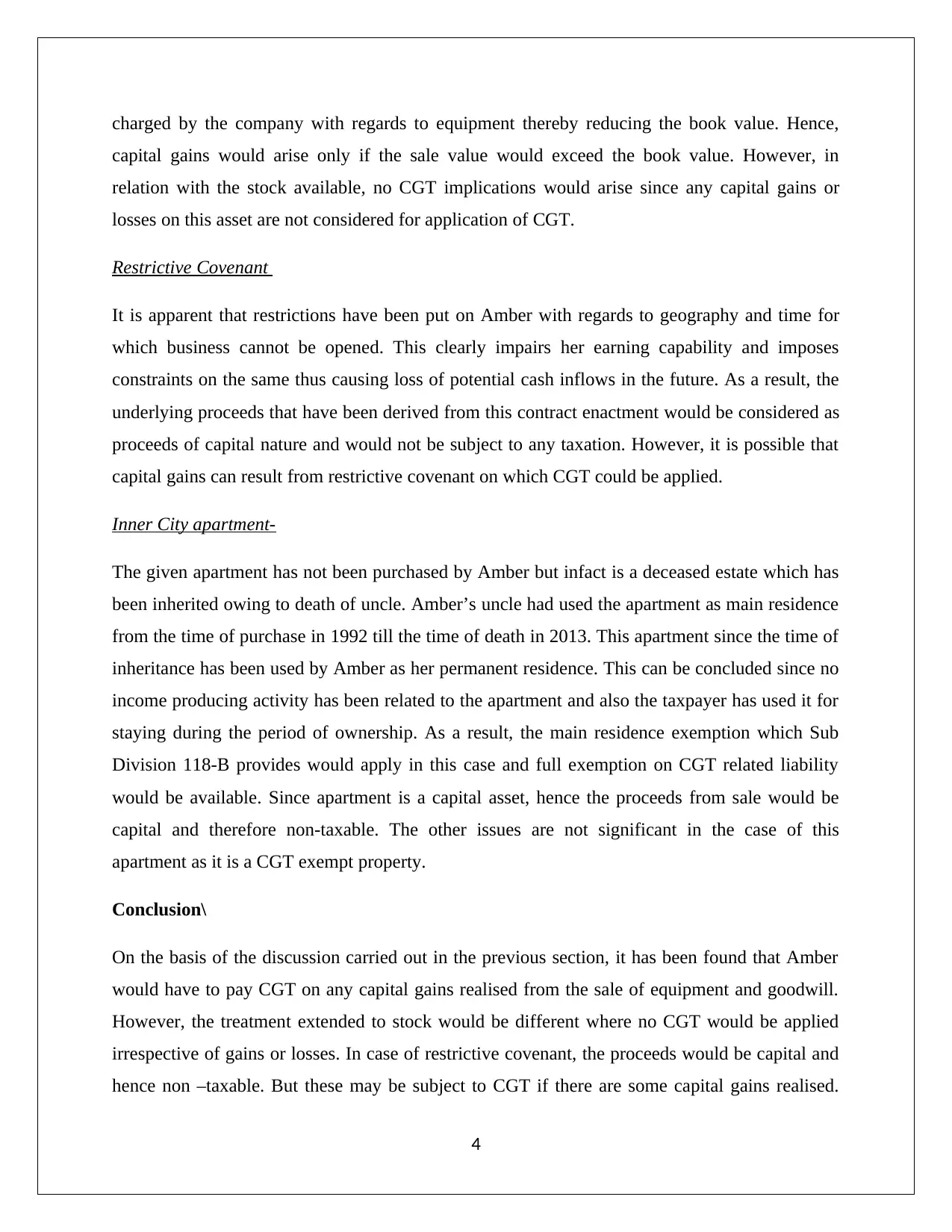
charged by the company with regards to equipment thereby reducing the book value. Hence,
capital gains would arise only if the sale value would exceed the book value. However, in
relation with the stock available, no CGT implications would arise since any capital gains or
losses on this asset are not considered for application of CGT.
Restrictive Covenant
It is apparent that restrictions have been put on Amber with regards to geography and time for
which business cannot be opened. This clearly impairs her earning capability and imposes
constraints on the same thus causing loss of potential cash inflows in the future. As a result, the
underlying proceeds that have been derived from this contract enactment would be considered as
proceeds of capital nature and would not be subject to any taxation. However, it is possible that
capital gains can result from restrictive covenant on which CGT could be applied.
Inner City apartment-
The given apartment has not been purchased by Amber but infact is a deceased estate which has
been inherited owing to death of uncle. Amber’s uncle had used the apartment as main residence
from the time of purchase in 1992 till the time of death in 2013. This apartment since the time of
inheritance has been used by Amber as her permanent residence. This can be concluded since no
income producing activity has been related to the apartment and also the taxpayer has used it for
staying during the period of ownership. As a result, the main residence exemption which Sub
Division 118-B provides would apply in this case and full exemption on CGT related liability
would be available. Since apartment is a capital asset, hence the proceeds from sale would be
capital and therefore non-taxable. The other issues are not significant in the case of this
apartment as it is a CGT exempt property.
Conclusion\
On the basis of the discussion carried out in the previous section, it has been found that Amber
would have to pay CGT on any capital gains realised from the sale of equipment and goodwill.
However, the treatment extended to stock would be different where no CGT would be applied
irrespective of gains or losses. In case of restrictive covenant, the proceeds would be capital and
hence non –taxable. But these may be subject to CGT if there are some capital gains realised.
4
capital gains would arise only if the sale value would exceed the book value. However, in
relation with the stock available, no CGT implications would arise since any capital gains or
losses on this asset are not considered for application of CGT.
Restrictive Covenant
It is apparent that restrictions have been put on Amber with regards to geography and time for
which business cannot be opened. This clearly impairs her earning capability and imposes
constraints on the same thus causing loss of potential cash inflows in the future. As a result, the
underlying proceeds that have been derived from this contract enactment would be considered as
proceeds of capital nature and would not be subject to any taxation. However, it is possible that
capital gains can result from restrictive covenant on which CGT could be applied.
Inner City apartment-
The given apartment has not been purchased by Amber but infact is a deceased estate which has
been inherited owing to death of uncle. Amber’s uncle had used the apartment as main residence
from the time of purchase in 1992 till the time of death in 2013. This apartment since the time of
inheritance has been used by Amber as her permanent residence. This can be concluded since no
income producing activity has been related to the apartment and also the taxpayer has used it for
staying during the period of ownership. As a result, the main residence exemption which Sub
Division 118-B provides would apply in this case and full exemption on CGT related liability
would be available. Since apartment is a capital asset, hence the proceeds from sale would be
capital and therefore non-taxable. The other issues are not significant in the case of this
apartment as it is a CGT exempt property.
Conclusion\
On the basis of the discussion carried out in the previous section, it has been found that Amber
would have to pay CGT on any capital gains realised from the sale of equipment and goodwill.
However, the treatment extended to stock would be different where no CGT would be applied
irrespective of gains or losses. In case of restrictive covenant, the proceeds would be capital and
hence non –taxable. But these may be subject to CGT if there are some capital gains realised.
4
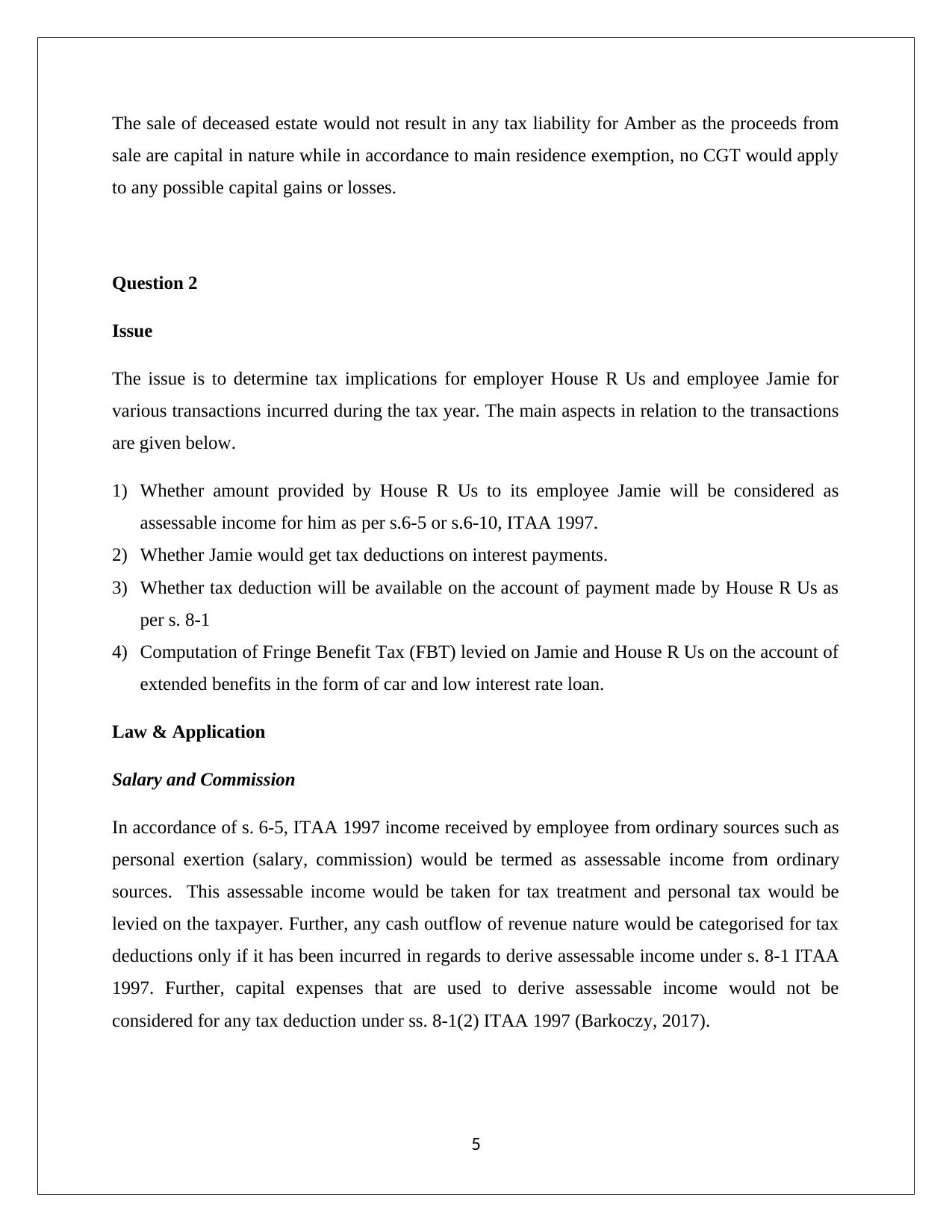
The sale of deceased estate would not result in any tax liability for Amber as the proceeds from
sale are capital in nature while in accordance to main residence exemption, no CGT would apply
to any possible capital gains or losses.
Question 2
Issue
The issue is to determine tax implications for employer House R Us and employee Jamie for
various transactions incurred during the tax year. The main aspects in relation to the transactions
are given below.
1) Whether amount provided by House R Us to its employee Jamie will be considered as
assessable income for him as per s.6-5 or s.6-10, ITAA 1997.
2) Whether Jamie would get tax deductions on interest payments.
3) Whether tax deduction will be available on the account of payment made by House R Us as
per s. 8-1
4) Computation of Fringe Benefit Tax (FBT) levied on Jamie and House R Us on the account of
extended benefits in the form of car and low interest rate loan.
Law & Application
Salary and Commission
In accordance of s. 6-5, ITAA 1997 income received by employee from ordinary sources such as
personal exertion (salary, commission) would be termed as assessable income from ordinary
sources. This assessable income would be taken for tax treatment and personal tax would be
levied on the taxpayer. Further, any cash outflow of revenue nature would be categorised for tax
deductions only if it has been incurred in regards to derive assessable income under s. 8-1 ITAA
1997. Further, capital expenses that are used to derive assessable income would not be
considered for any tax deduction under ss. 8-1(2) ITAA 1997 (Barkoczy, 2017).
5
sale are capital in nature while in accordance to main residence exemption, no CGT would apply
to any possible capital gains or losses.
Question 2
Issue
The issue is to determine tax implications for employer House R Us and employee Jamie for
various transactions incurred during the tax year. The main aspects in relation to the transactions
are given below.
1) Whether amount provided by House R Us to its employee Jamie will be considered as
assessable income for him as per s.6-5 or s.6-10, ITAA 1997.
2) Whether Jamie would get tax deductions on interest payments.
3) Whether tax deduction will be available on the account of payment made by House R Us as
per s. 8-1
4) Computation of Fringe Benefit Tax (FBT) levied on Jamie and House R Us on the account of
extended benefits in the form of car and low interest rate loan.
Law & Application
Salary and Commission
In accordance of s. 6-5, ITAA 1997 income received by employee from ordinary sources such as
personal exertion (salary, commission) would be termed as assessable income from ordinary
sources. This assessable income would be taken for tax treatment and personal tax would be
levied on the taxpayer. Further, any cash outflow of revenue nature would be categorised for tax
deductions only if it has been incurred in regards to derive assessable income under s. 8-1 ITAA
1997. Further, capital expenses that are used to derive assessable income would not be
considered for any tax deduction under ss. 8-1(2) ITAA 1997 (Barkoczy, 2017).
5
⊘ This is a preview!⊘
Do you want full access?
Subscribe today to unlock all pages.

Trusted by 1+ million students worldwide
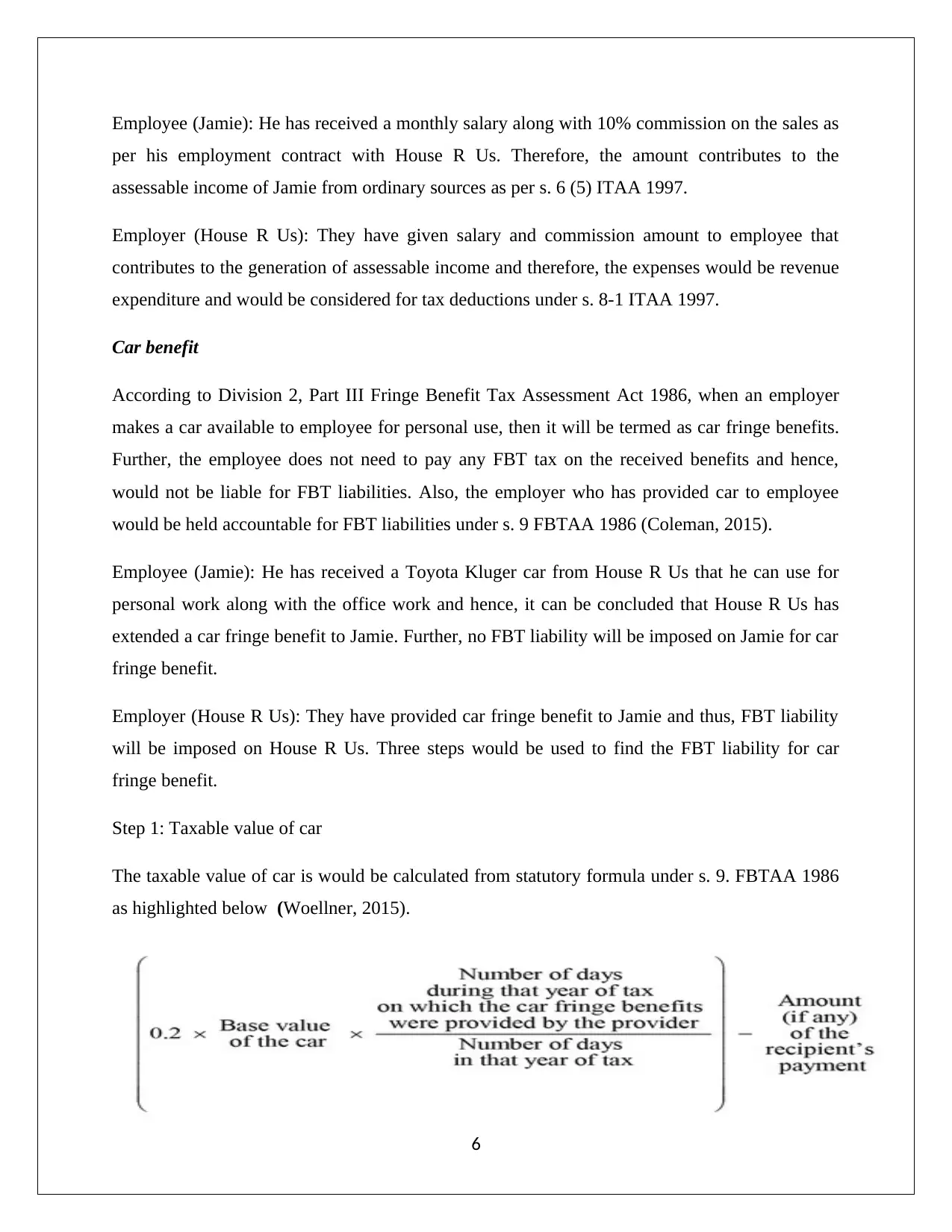
Employee (Jamie): He has received a monthly salary along with 10% commission on the sales as
per his employment contract with House R Us. Therefore, the amount contributes to the
assessable income of Jamie from ordinary sources as per s. 6 (5) ITAA 1997.
Employer (House R Us): They have given salary and commission amount to employee that
contributes to the generation of assessable income and therefore, the expenses would be revenue
expenditure and would be considered for tax deductions under s. 8-1 ITAA 1997.
Car benefit
According to Division 2, Part III Fringe Benefit Tax Assessment Act 1986, when an employer
makes a car available to employee for personal use, then it will be termed as car fringe benefits.
Further, the employee does not need to pay any FBT tax on the received benefits and hence,
would not be liable for FBT liabilities. Also, the employer who has provided car to employee
would be held accountable for FBT liabilities under s. 9 FBTAA 1986 (Coleman, 2015).
Employee (Jamie): He has received a Toyota Kluger car from House R Us that he can use for
personal work along with the office work and hence, it can be concluded that House R Us has
extended a car fringe benefit to Jamie. Further, no FBT liability will be imposed on Jamie for car
fringe benefit.
Employer (House R Us): They have provided car fringe benefit to Jamie and thus, FBT liability
will be imposed on House R Us. Three steps would be used to find the FBT liability for car
fringe benefit.
Step 1: Taxable value of car
The taxable value of car is would be calculated from statutory formula under s. 9. FBTAA 1986
as highlighted below (Woellner, 2015).
6
per his employment contract with House R Us. Therefore, the amount contributes to the
assessable income of Jamie from ordinary sources as per s. 6 (5) ITAA 1997.
Employer (House R Us): They have given salary and commission amount to employee that
contributes to the generation of assessable income and therefore, the expenses would be revenue
expenditure and would be considered for tax deductions under s. 8-1 ITAA 1997.
Car benefit
According to Division 2, Part III Fringe Benefit Tax Assessment Act 1986, when an employer
makes a car available to employee for personal use, then it will be termed as car fringe benefits.
Further, the employee does not need to pay any FBT tax on the received benefits and hence,
would not be liable for FBT liabilities. Also, the employer who has provided car to employee
would be held accountable for FBT liabilities under s. 9 FBTAA 1986 (Coleman, 2015).
Employee (Jamie): He has received a Toyota Kluger car from House R Us that he can use for
personal work along with the office work and hence, it can be concluded that House R Us has
extended a car fringe benefit to Jamie. Further, no FBT liability will be imposed on Jamie for car
fringe benefit.
Employer (House R Us): They have provided car fringe benefit to Jamie and thus, FBT liability
will be imposed on House R Us. Three steps would be used to find the FBT liability for car
fringe benefit.
Step 1: Taxable value of car
The taxable value of car is would be calculated from statutory formula under s. 9. FBTAA 1986
as highlighted below (Woellner, 2015).
6
Paraphrase This Document
Need a fresh take? Get an instant paraphrase of this document with our AI Paraphraser
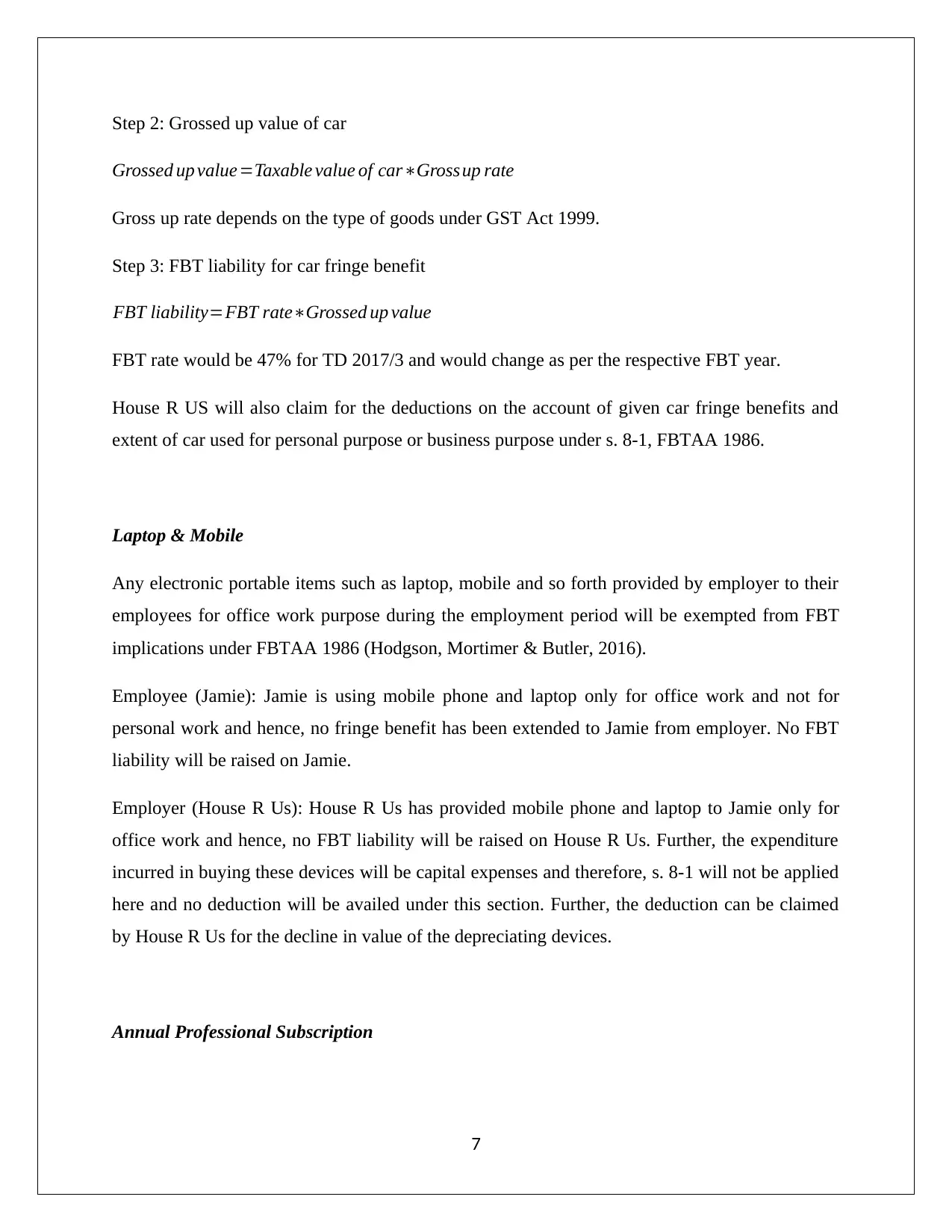
Step 2: Grossed up value of car
Grossed up value=Taxable value of car∗Grossup rate
Gross up rate depends on the type of goods under GST Act 1999.
Step 3: FBT liability for car fringe benefit
FBT liability=FBT rate∗Grossed up value
FBT rate would be 47% for TD 2017/3 and would change as per the respective FBT year.
House R US will also claim for the deductions on the account of given car fringe benefits and
extent of car used for personal purpose or business purpose under s. 8-1, FBTAA 1986.
Laptop & Mobile
Any electronic portable items such as laptop, mobile and so forth provided by employer to their
employees for office work purpose during the employment period will be exempted from FBT
implications under FBTAA 1986 (Hodgson, Mortimer & Butler, 2016).
Employee (Jamie): Jamie is using mobile phone and laptop only for office work and not for
personal work and hence, no fringe benefit has been extended to Jamie from employer. No FBT
liability will be raised on Jamie.
Employer (House R Us): House R Us has provided mobile phone and laptop to Jamie only for
office work and hence, no FBT liability will be raised on House R Us. Further, the expenditure
incurred in buying these devices will be capital expenses and therefore, s. 8-1 will not be applied
here and no deduction will be availed under this section. Further, the deduction can be claimed
by House R Us for the decline in value of the depreciating devices.
Annual Professional Subscription
7
Grossed up value=Taxable value of car∗Grossup rate
Gross up rate depends on the type of goods under GST Act 1999.
Step 3: FBT liability for car fringe benefit
FBT liability=FBT rate∗Grossed up value
FBT rate would be 47% for TD 2017/3 and would change as per the respective FBT year.
House R US will also claim for the deductions on the account of given car fringe benefits and
extent of car used for personal purpose or business purpose under s. 8-1, FBTAA 1986.
Laptop & Mobile
Any electronic portable items such as laptop, mobile and so forth provided by employer to their
employees for office work purpose during the employment period will be exempted from FBT
implications under FBTAA 1986 (Hodgson, Mortimer & Butler, 2016).
Employee (Jamie): Jamie is using mobile phone and laptop only for office work and not for
personal work and hence, no fringe benefit has been extended to Jamie from employer. No FBT
liability will be raised on Jamie.
Employer (House R Us): House R Us has provided mobile phone and laptop to Jamie only for
office work and hence, no FBT liability will be raised on House R Us. Further, the expenditure
incurred in buying these devices will be capital expenses and therefore, s. 8-1 will not be applied
here and no deduction will be availed under this section. Further, the deduction can be claimed
by House R Us for the decline in value of the depreciating devices.
Annual Professional Subscription
7
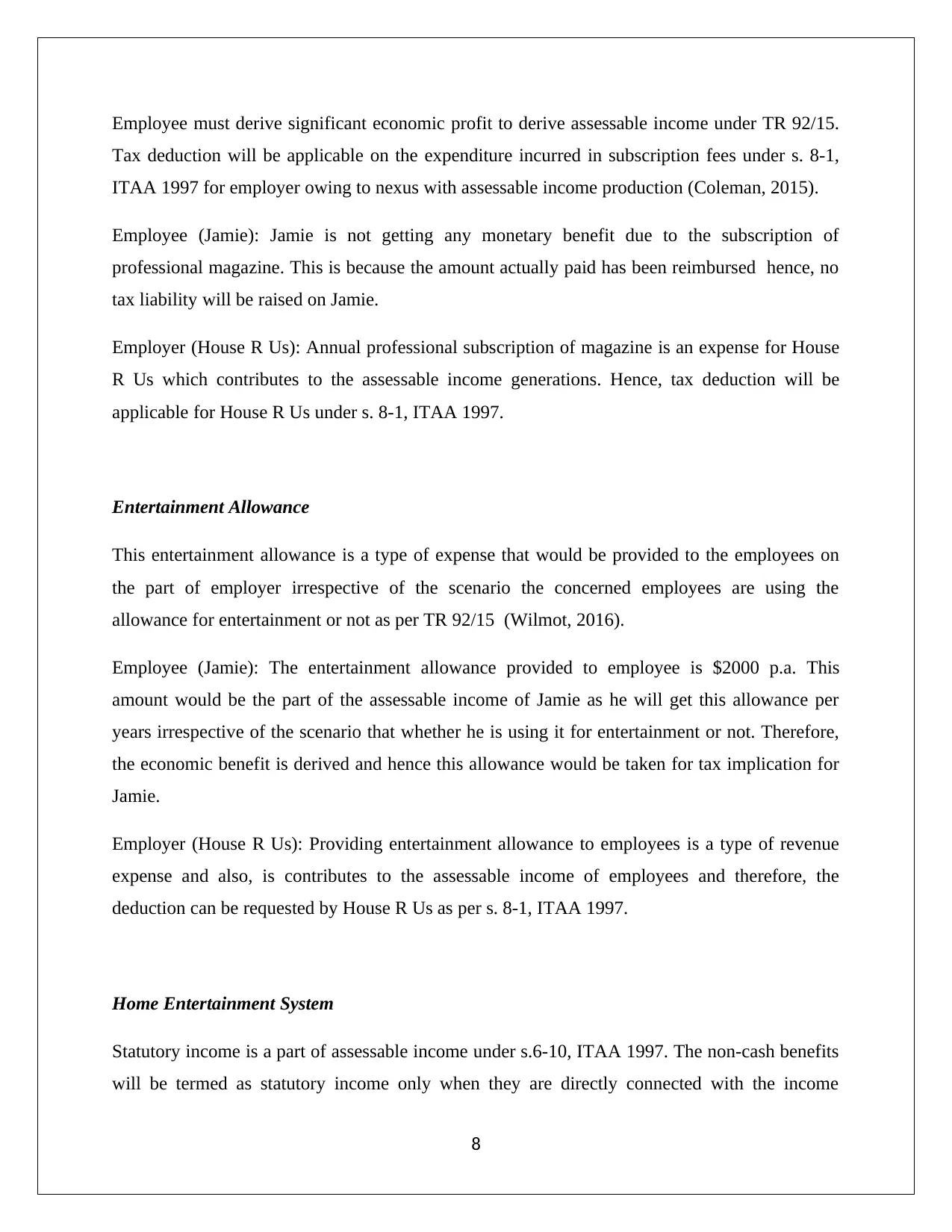
Employee must derive significant economic profit to derive assessable income under TR 92/15.
Tax deduction will be applicable on the expenditure incurred in subscription fees under s. 8-1,
ITAA 1997 for employer owing to nexus with assessable income production (Coleman, 2015).
Employee (Jamie): Jamie is not getting any monetary benefit due to the subscription of
professional magazine. This is because the amount actually paid has been reimbursed hence, no
tax liability will be raised on Jamie.
Employer (House R Us): Annual professional subscription of magazine is an expense for House
R Us which contributes to the assessable income generations. Hence, tax deduction will be
applicable for House R Us under s. 8-1, ITAA 1997.
Entertainment Allowance
This entertainment allowance is a type of expense that would be provided to the employees on
the part of employer irrespective of the scenario the concerned employees are using the
allowance for entertainment or not as per TR 92/15 (Wilmot, 2016).
Employee (Jamie): The entertainment allowance provided to employee is $2000 p.a. This
amount would be the part of the assessable income of Jamie as he will get this allowance per
years irrespective of the scenario that whether he is using it for entertainment or not. Therefore,
the economic benefit is derived and hence this allowance would be taken for tax implication for
Jamie.
Employer (House R Us): Providing entertainment allowance to employees is a type of revenue
expense and also, is contributes to the assessable income of employees and therefore, the
deduction can be requested by House R Us as per s. 8-1, ITAA 1997.
Home Entertainment System
Statutory income is a part of assessable income under s.6-10, ITAA 1997. The non-cash benefits
will be termed as statutory income only when they are directly connected with the income
8
Tax deduction will be applicable on the expenditure incurred in subscription fees under s. 8-1,
ITAA 1997 for employer owing to nexus with assessable income production (Coleman, 2015).
Employee (Jamie): Jamie is not getting any monetary benefit due to the subscription of
professional magazine. This is because the amount actually paid has been reimbursed hence, no
tax liability will be raised on Jamie.
Employer (House R Us): Annual professional subscription of magazine is an expense for House
R Us which contributes to the assessable income generations. Hence, tax deduction will be
applicable for House R Us under s. 8-1, ITAA 1997.
Entertainment Allowance
This entertainment allowance is a type of expense that would be provided to the employees on
the part of employer irrespective of the scenario the concerned employees are using the
allowance for entertainment or not as per TR 92/15 (Wilmot, 2016).
Employee (Jamie): The entertainment allowance provided to employee is $2000 p.a. This
amount would be the part of the assessable income of Jamie as he will get this allowance per
years irrespective of the scenario that whether he is using it for entertainment or not. Therefore,
the economic benefit is derived and hence this allowance would be taken for tax implication for
Jamie.
Employer (House R Us): Providing entertainment allowance to employees is a type of revenue
expense and also, is contributes to the assessable income of employees and therefore, the
deduction can be requested by House R Us as per s. 8-1, ITAA 1997.
Home Entertainment System
Statutory income is a part of assessable income under s.6-10, ITAA 1997. The non-cash benefits
will be termed as statutory income only when they are directly connected with the income
8
⊘ This is a preview!⊘
Do you want full access?
Subscribe today to unlock all pages.

Trusted by 1+ million students worldwide
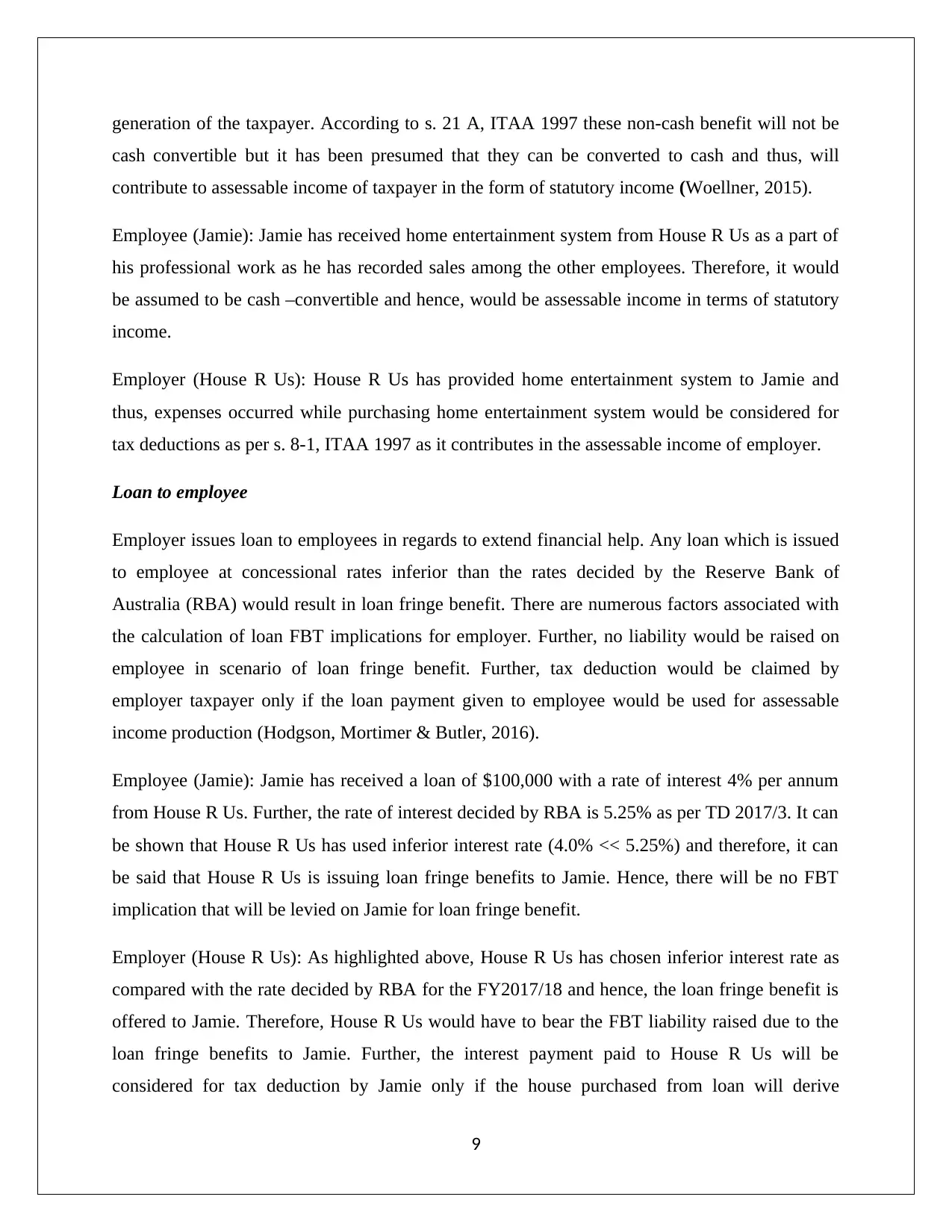
generation of the taxpayer. According to s. 21 A, ITAA 1997 these non-cash benefit will not be
cash convertible but it has been presumed that they can be converted to cash and thus, will
contribute to assessable income of taxpayer in the form of statutory income (Woellner, 2015).
Employee (Jamie): Jamie has received home entertainment system from House R Us as a part of
his professional work as he has recorded sales among the other employees. Therefore, it would
be assumed to be cash –convertible and hence, would be assessable income in terms of statutory
income.
Employer (House R Us): House R Us has provided home entertainment system to Jamie and
thus, expenses occurred while purchasing home entertainment system would be considered for
tax deductions as per s. 8-1, ITAA 1997 as it contributes in the assessable income of employer.
Loan to employee
Employer issues loan to employees in regards to extend financial help. Any loan which is issued
to employee at concessional rates inferior than the rates decided by the Reserve Bank of
Australia (RBA) would result in loan fringe benefit. There are numerous factors associated with
the calculation of loan FBT implications for employer. Further, no liability would be raised on
employee in scenario of loan fringe benefit. Further, tax deduction would be claimed by
employer taxpayer only if the loan payment given to employee would be used for assessable
income production (Hodgson, Mortimer & Butler, 2016).
Employee (Jamie): Jamie has received a loan of $100,000 with a rate of interest 4% per annum
from House R Us. Further, the rate of interest decided by RBA is 5.25% as per TD 2017/3. It can
be shown that House R Us has used inferior interest rate (4.0% << 5.25%) and therefore, it can
be said that House R Us is issuing loan fringe benefits to Jamie. Hence, there will be no FBT
implication that will be levied on Jamie for loan fringe benefit.
Employer (House R Us): As highlighted above, House R Us has chosen inferior interest rate as
compared with the rate decided by RBA for the FY2017/18 and hence, the loan fringe benefit is
offered to Jamie. Therefore, House R Us would have to bear the FBT liability raised due to the
loan fringe benefits to Jamie. Further, the interest payment paid to House R Us will be
considered for tax deduction by Jamie only if the house purchased from loan will derive
9
cash convertible but it has been presumed that they can be converted to cash and thus, will
contribute to assessable income of taxpayer in the form of statutory income (Woellner, 2015).
Employee (Jamie): Jamie has received home entertainment system from House R Us as a part of
his professional work as he has recorded sales among the other employees. Therefore, it would
be assumed to be cash –convertible and hence, would be assessable income in terms of statutory
income.
Employer (House R Us): House R Us has provided home entertainment system to Jamie and
thus, expenses occurred while purchasing home entertainment system would be considered for
tax deductions as per s. 8-1, ITAA 1997 as it contributes in the assessable income of employer.
Loan to employee
Employer issues loan to employees in regards to extend financial help. Any loan which is issued
to employee at concessional rates inferior than the rates decided by the Reserve Bank of
Australia (RBA) would result in loan fringe benefit. There are numerous factors associated with
the calculation of loan FBT implications for employer. Further, no liability would be raised on
employee in scenario of loan fringe benefit. Further, tax deduction would be claimed by
employer taxpayer only if the loan payment given to employee would be used for assessable
income production (Hodgson, Mortimer & Butler, 2016).
Employee (Jamie): Jamie has received a loan of $100,000 with a rate of interest 4% per annum
from House R Us. Further, the rate of interest decided by RBA is 5.25% as per TD 2017/3. It can
be shown that House R Us has used inferior interest rate (4.0% << 5.25%) and therefore, it can
be said that House R Us is issuing loan fringe benefits to Jamie. Hence, there will be no FBT
implication that will be levied on Jamie for loan fringe benefit.
Employer (House R Us): As highlighted above, House R Us has chosen inferior interest rate as
compared with the rate decided by RBA for the FY2017/18 and hence, the loan fringe benefit is
offered to Jamie. Therefore, House R Us would have to bear the FBT liability raised due to the
loan fringe benefits to Jamie. Further, the interest payment paid to House R Us will be
considered for tax deduction by Jamie only if the house purchased from loan will derive
9
Paraphrase This Document
Need a fresh take? Get an instant paraphrase of this document with our AI Paraphraser
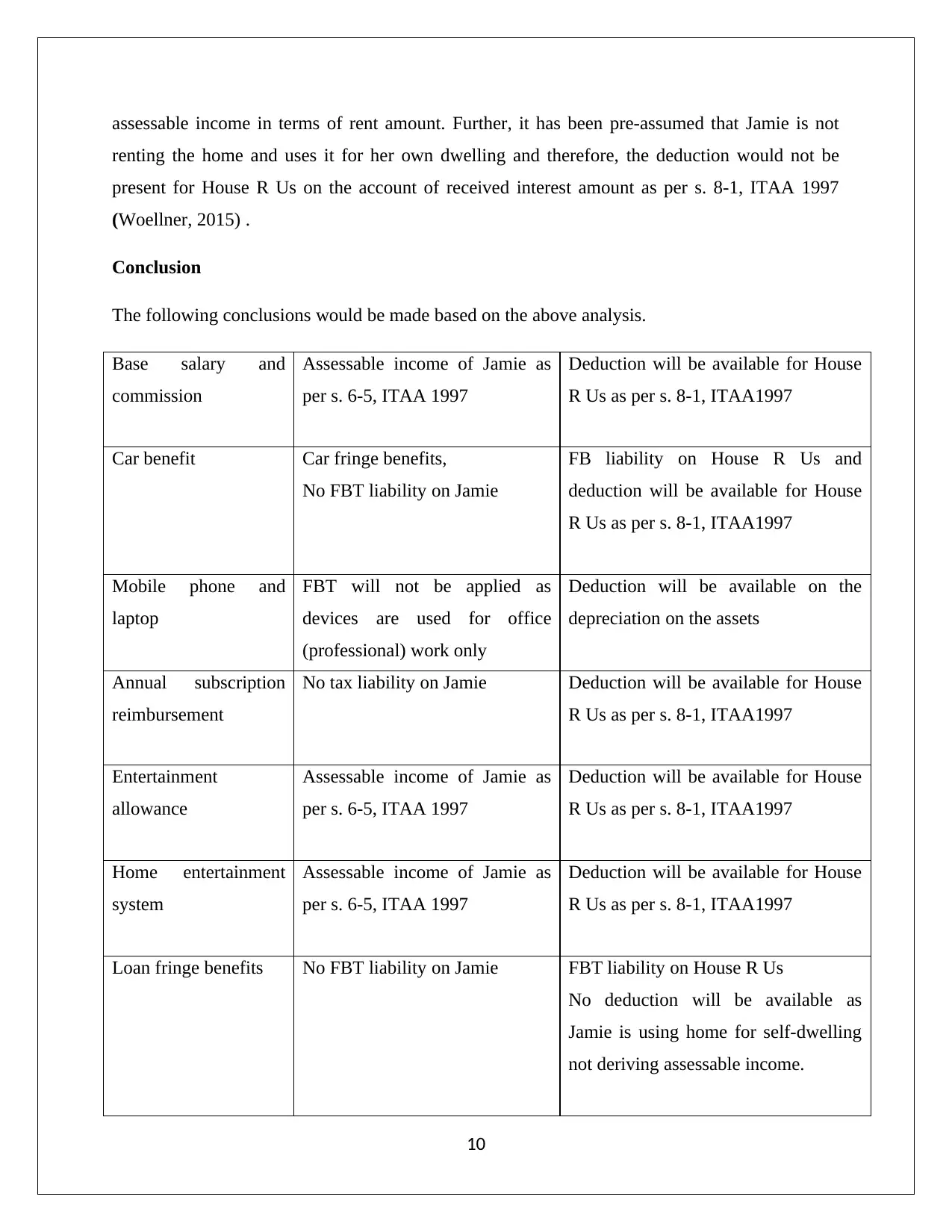
assessable income in terms of rent amount. Further, it has been pre-assumed that Jamie is not
renting the home and uses it for her own dwelling and therefore, the deduction would not be
present for House R Us on the account of received interest amount as per s. 8-1, ITAA 1997
(Woellner, 2015) .
Conclusion
The following conclusions would be made based on the above analysis.
Base salary and
commission
Assessable income of Jamie as
per s. 6-5, ITAA 1997
Deduction will be available for House
R Us as per s. 8-1, ITAA1997
Car benefit Car fringe benefits,
No FBT liability on Jamie
FB liability on House R Us and
deduction will be available for House
R Us as per s. 8-1, ITAA1997
Mobile phone and
laptop
FBT will not be applied as
devices are used for office
(professional) work only
Deduction will be available on the
depreciation on the assets
Annual subscription
reimbursement
No tax liability on Jamie Deduction will be available for House
R Us as per s. 8-1, ITAA1997
Entertainment
allowance
Assessable income of Jamie as
per s. 6-5, ITAA 1997
Deduction will be available for House
R Us as per s. 8-1, ITAA1997
Home entertainment
system
Assessable income of Jamie as
per s. 6-5, ITAA 1997
Deduction will be available for House
R Us as per s. 8-1, ITAA1997
Loan fringe benefits No FBT liability on Jamie FBT liability on House R Us
No deduction will be available as
Jamie is using home for self-dwelling
not deriving assessable income.
10
renting the home and uses it for her own dwelling and therefore, the deduction would not be
present for House R Us on the account of received interest amount as per s. 8-1, ITAA 1997
(Woellner, 2015) .
Conclusion
The following conclusions would be made based on the above analysis.
Base salary and
commission
Assessable income of Jamie as
per s. 6-5, ITAA 1997
Deduction will be available for House
R Us as per s. 8-1, ITAA1997
Car benefit Car fringe benefits,
No FBT liability on Jamie
FB liability on House R Us and
deduction will be available for House
R Us as per s. 8-1, ITAA1997
Mobile phone and
laptop
FBT will not be applied as
devices are used for office
(professional) work only
Deduction will be available on the
depreciation on the assets
Annual subscription
reimbursement
No tax liability on Jamie Deduction will be available for House
R Us as per s. 8-1, ITAA1997
Entertainment
allowance
Assessable income of Jamie as
per s. 6-5, ITAA 1997
Deduction will be available for House
R Us as per s. 8-1, ITAA1997
Home entertainment
system
Assessable income of Jamie as
per s. 6-5, ITAA 1997
Deduction will be available for House
R Us as per s. 8-1, ITAA1997
Loan fringe benefits No FBT liability on Jamie FBT liability on House R Us
No deduction will be available as
Jamie is using home for self-dwelling
not deriving assessable income.
10

11
⊘ This is a preview!⊘
Do you want full access?
Subscribe today to unlock all pages.

Trusted by 1+ million students worldwide
1 out of 13
Related Documents
Your All-in-One AI-Powered Toolkit for Academic Success.
+13062052269
info@desklib.com
Available 24*7 on WhatsApp / Email
![[object Object]](/_next/static/media/star-bottom.7253800d.svg)
Unlock your academic potential
Copyright © 2020–2025 A2Z Services. All Rights Reserved. Developed and managed by ZUCOL.




